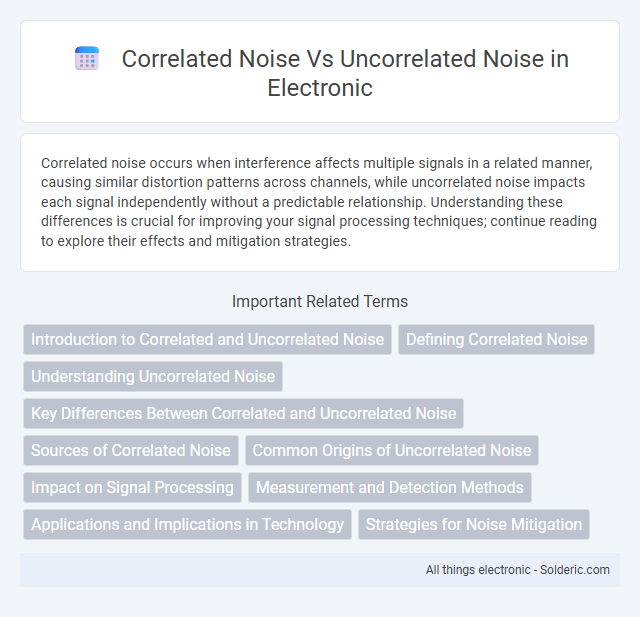Correlated noise occurs when interference affects multiple signals in a related manner, causing similar distortion patterns across channels, while uncorrelated noise impacts each signal independently without a predictable relationship. Understanding these differences is crucial for improving your signal processing techniques; continue reading to explore their effects and mitigation strategies.
Comparison Table
| Aspect | Correlated Noise | Uncorrelated Noise |
|---|---|---|
| Definition | Noise with statistical dependence between signals or sensors | Noise with no statistical relationship across signals or sensors |
| Statistical Property | Dependent random variables | Independent random variables |
| Effect on Signal Processing | Can cause bias, complicates noise reduction | Easier to isolate and filter out |
| Occurrence Examples | Sensor arrays, EEG recordings, spatially close antennas | Thermal noise, shot noise, uncorrelated sensor errors |
| Noise Model | Modeled by covariance matrices with off-diagonal terms | Diagonal covariance matrix (independent variances) |
| Impact on Data Analysis | Requires complex statistical methods (e.g., whitening) | Standard noise filtering techniques suffice |
| Example in Communications | Interference affecting multiple channels simultaneously | Random additive white Gaussian noise (AWGN) |
Introduction to Correlated and Uncorrelated Noise
Correlated noise refers to interference signals that share a predictable relationship across multiple channels or sensors, often arising from common sources or environmental conditions. Uncorrelated noise, in contrast, consists of random fluctuations occurring independently in each channel, lacking any mutual dependency or pattern. Understanding the distinction between correlated and uncorrelated noise helps you optimize signal processing techniques for accurate data analysis and improved system performance.
Defining Correlated Noise
Correlated noise occurs when noise signals exhibit a dependency or relationship across multiple channels or components, causing interference patterns that are not independent. Unlike uncorrelated noise, which affects each signal source randomly and independently, correlated noise can degrade system performance by introducing consistent distortion across measurements. Understanding the nature of correlated noise is essential for designing filters and algorithms that effectively mitigate its impact on Your signal processing tasks.
Understanding Uncorrelated Noise
Uncorrelated noise refers to random disturbances in signals or data that occur independently across different channels or time points, lacking any statistical relationship. This type of noise is characterized by zero cross-correlation, meaning that fluctuations in one signal do not predict or influence fluctuations in another. Understanding uncorrelated noise is crucial in signal processing and data analysis to design effective filters and improve system performance by isolating true signals from random variations.
Key Differences Between Correlated and Uncorrelated Noise
Correlated noise occurs when noise signals exhibit a predictable relationship across different sensors or channels, often arising from a common source, while uncorrelated noise exists independently with no statistical relationship between signals. Correlated noise typically degrades system performance in applications like array processing and communications by introducing bias, whereas uncorrelated noise primarily affects signal-to-noise ratio and can often be averaged out or mitigated using standard filtering techniques. Techniques such as covariance matrix analysis and spatial filtering exploit the distinctions between correlated and uncorrelated noise to enhance signal detection and improve overall system robustness.
Sources of Correlated Noise
Sources of correlated noise often stem from environmental factors such as electromagnetic interference, temperature fluctuations, or shared power supplies that simultaneously affect multiple sensors or channels. In contrast to uncorrelated noise, which arises from independent random processes, correlated noise is linked by common external or internal influences, causing similar disturbances across measurements. Understanding these sources helps you implement effective noise reduction techniques in multi-sensor or multi-channel systems, improving data accuracy and reliability.
Common Origins of Uncorrelated Noise
Uncorrelated noise arises from independent sources such as thermal vibrations in electronic components, shot noise due to discrete charge carriers, and quantization noise in digital signal processing. These noise types do not share a common phase or amplitude relationship across different channels or sensors, making their combined effect less predictable and more challenging to filter. Understanding uncorrelated noise origins is essential for designing systems that minimize overall noise impact in communication and measurement applications.
Impact on Signal Processing
Correlated noise introduces dependencies between noise samples, which can degrade signal processing algorithms by causing biased estimations and reducing the effectiveness of noise filtering. Uncorrelated noise, often modeled as white noise, maintains statistical independence between samples, allowing conventional filters and detectors to perform optimally. Understanding the distinction between these noise types is crucial for designing robust signal processing techniques that preserve signal integrity and enhance your system's performance.
Measurement and Detection Methods
Correlated noise detection relies on cross-correlation techniques that identify consistent signal components across multiple sensors, improving signal-to-noise ratio in measurements such as radar and seismic data. Uncorrelated noise is addressed using averaging and filtering methods like Wiener filters that assume noise independence to reduce random fluctuations in measurements. Advanced detection methods employ spectral analysis and covariance matrix estimation to distinguish correlated noise patterns from uncorrelated noise in physical and communication systems.
Applications and Implications in Technology
Correlated noise, often found in sensor arrays and communication systems, impacts signal processing techniques by introducing dependencies that can be exploited for noise reduction and improved data accuracy. Uncorrelated noise, common in thermal and shot noise sources, simplifies filtering algorithms but may limit overall system performance due to its random nature. Understanding these noise characteristics helps you optimize device design and enhance reliability in applications like imaging, telecommunications, and data acquisition.
Strategies for Noise Mitigation
Noise mitigation strategies for correlated and uncorrelated noise differ significantly due to the nature of their dependencies. For correlated noise, spatial filtering and adaptive algorithms employing covariance matrix estimation enhance signal extraction by exploiting noise correlations across sensors. In contrast, uncorrelated noise mitigation relies heavily on averaging techniques, independent component analysis, and hardware design improvements that reduce random noise sources at individual sensor levels.
Correlated noise vs uncorrelated noise Infographic

 solderic.com
solderic.com